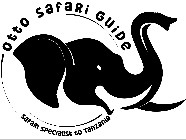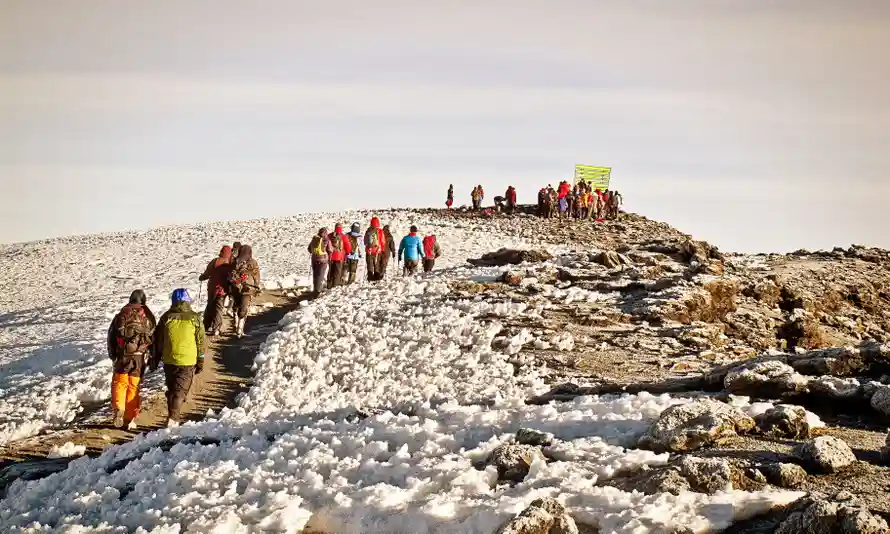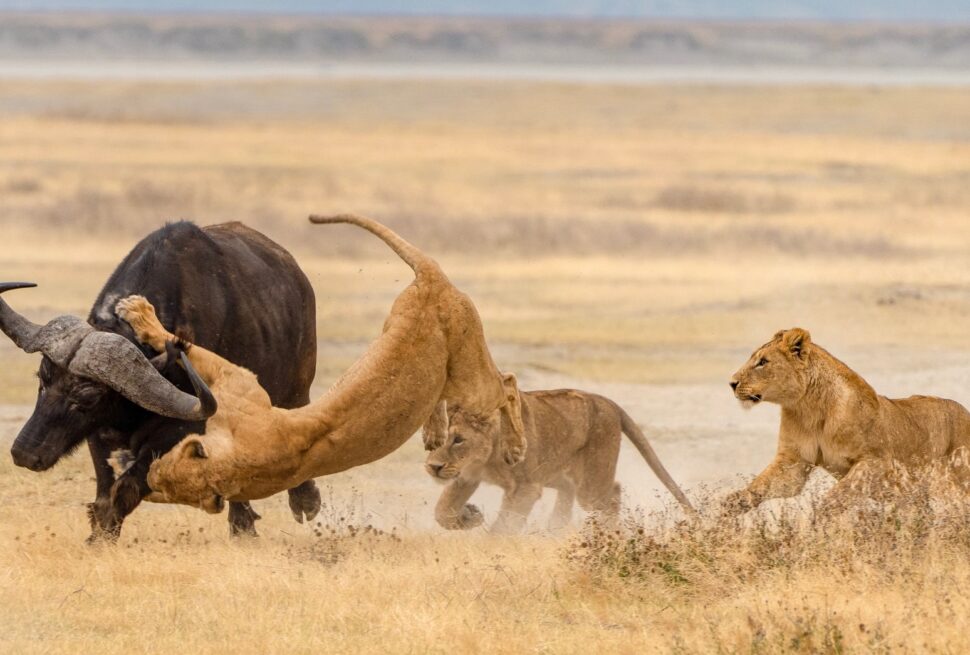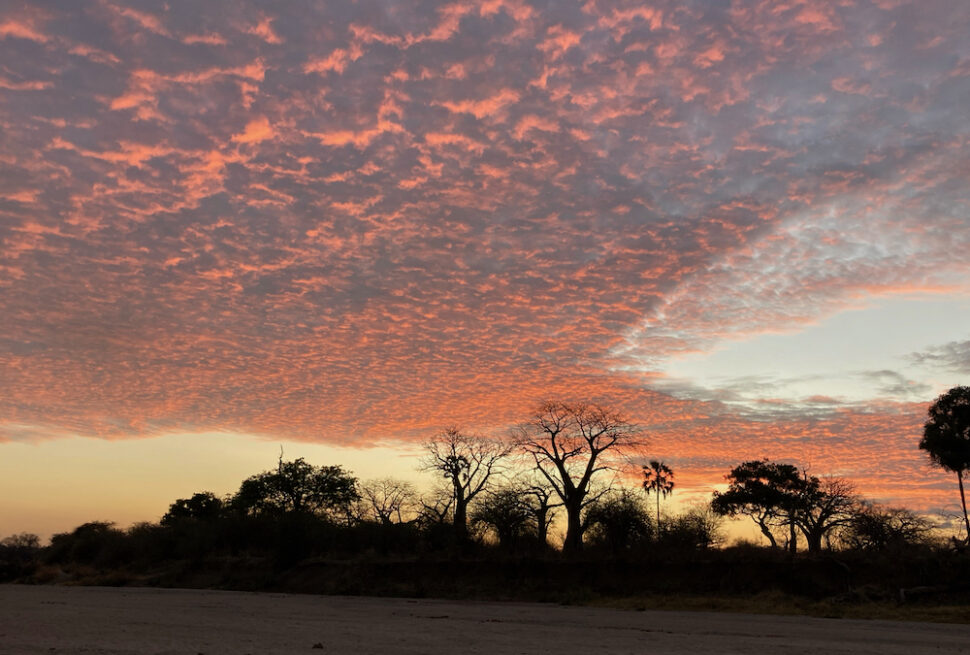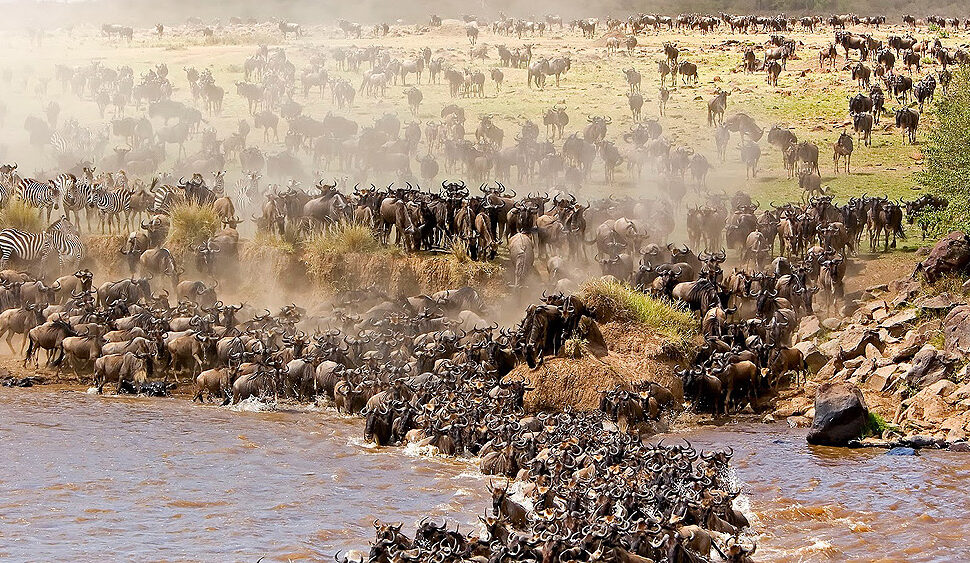Are you considering climbing Mount Kilimanjaro? You’ve been bitten by the Kili bug, and whenever you get a chance, you’re researching your Kilimanjaro climb. We understand how you feel. It’s a yearning for Africa’s Roof. An irrepressible ambition for reaching Uhuru Peak and a craving for the sheer adventure that a Kilimanjaro climb brings with. Every year, We assist hundreds of climbers on their way to Uhuru Peak.
When you are climbing Kilimanjaro you will make it to a location at a height of 5.895 meters altitude above sea-level. For the past 3 million years, it has been the tough man. The mountain has made climbers’ lives incredibly difficult over the past 130 years, but it has been well worth it. You can reach the highest point on the African continent with the appropriate preparations and answers to the right questions. Mount Kilimanjaro is one of the Seven Summits, and while it is considered to be one of the simpler ones to climb, it is far from easy. Are you up for the challenge of climbing Mount Kilimanjaro? That’s all there is to it.
We assist many of climbers each year on their way to the summit of Mount Kilimanjaro. This link will take you to a page where you can see all of our Kilimanjaro climbing itineraries.
In this Article fitures the following
- Kilimanjaro Climbing and COVID-19: Is the Mountain Prepared?
- What is the time it takes to climb Mount Kilimanjaro?
- What is the location of Mount Kilimanjaro?
- What is the height of Kilimanjaro?
- When is the best time to climb Mount Kilimanjaro?
- How Much Does Climbing Kilimanjaro Cost?
- How Difficult Is It To Climb Mount Kilimanjaro?
- The Best Kilimanjaro Climbing Route
- What is the Most Economical Way to Climb Mount Kilimanjaro?
- Kilimanjaro Climbing Training – How Do You Prepare to Climb Kilimanjaro?
- What Should You Bring on Mount Kilimanjaro?
- Combine Kilimanjaro Climb with Mount Meru or a Safari
- Where Do I Stay Before and After my Kilimanjaro Climb?
- Facts: Who Was the First to Climb Mount Kilimanjaro?
- All You Need To Know To Climb Kilimanjaro
- Kilimanjaro Climbing and COVID-19: Is the Mountain Prepared?
Everything is in place for tourism to resume in northern Tanzania, particularly near Mount Kilimanjaro and in the country’s greatest national parks, such as the Serengeti. “In Northern Tanzania, tourism is one of the few sources of revenue. Unfortunately, the government has not provided us with much financial assistance, and as a result, the entire region has been severely impacted. Poverty exists. The airport (Kilimanjaro International Airport, eg.) is open, and body temperatures are taken in all public areas. At the entrance to Kilimanjaro National Park, as well. The situation is taken very seriously by the park authorities.”
Rangers take your temperature at the Kilimanjaro entrance. If the temperature is too high, you are not permitted to enter the park, and quarantine is the order of the day. Climbers’ health is also aggressively examined during the ascent. “Of course, when it comes to altitude sickness, we’ve already done that.” COVID-19 is now available. In the park, mouth caps are required, and guides, cooks, porters, and climbers must sanitize their hands on a regular basis.”
What is the time it takes to climb Mount Kilimanjaro?
We understand that you can’t take unlimited vacation time, and it’s highly probable that you’re attempting to fit a Kilimanjaro climb into your well-earned week off. This is technically doable, but if you want to reach Uhuru Peak, we recommend not cutting it short. You might as well take it easy once you’re on your way to climb Kilimanjaro. Climbing Kilimanjaro could be a once-in-a-lifetime experience. What’s the harm in that?
Acclimatization is a good option.
Climbing Kilimanjaro takes anything from 5 to 9 days. “Why do it in 9 days when you can do it in 5 or 6 days?” you might question. If you’re just starting to consider your alternatives for climbing Kilimanjaro, the answer isn’t so straightforward. It all boils down to becoming used to the environment. The men who chose to climb Kilimanjaro in nine days have the highest chance of reaching the summit.
The guys who do it in 5 days can become sick halfway through and be forced to stop it short. The Marangu Route was chosen by these guys, and while they had the luxury of living in huts, their acclimatization wasn’t exactly textbook best practice. You shouldn’t take the quickest route up if you want adequate acclimatization and to reduce the danger of Altitude Mountain Sickness (AMS).
Choose the slowest option. When comparing a 6-day Machame Route to a 7-day Machame Route, don’t look at the price. No, take a look at the timeframe. 7 days is preferable to 6 days. Remember what we advised if you rejected this advice and find yourself vomiting at Stella Point. Also, if you’re considering climbing Kilimanjaro, the Lemosho Route is a wonderful alternative for acclimatization.
What is the location of Mount Kilimanjaro?
Mount Kilimanjaro should not be confused with other prominent African mountains such as Mount Kenya or Morocco’s Atlas. Mount Kenya is located in Kenya, and Mount Kilimanjaro is located in Tanzania, East Africa. The mountain climbs 5,895 meters (19,340 feet) above sea level, making it one among the seven summits (the highest peaks on each of the seven continents). It is the world’s tallest freestanding mountain (one that is not part of a mountain range).
What is the height of Kilimanjaro?
Kilimanjaro has been climbed to various heights throughout history. Kilimanjaro stands at a height of 5,895 meters. Kilimanjaro stands at 19,340 feet in feet. Right? Yes, but there have been many heights in the past, and if modern GPS technologies are to be believed, the mountain isn’t that high. Kilimanjaro’s most recent GPS scan was in 2008, and the results revealed that the mountain is not nearly as high as it appears: 5,891.8 meters (19,330 ft).
But did you know that for a time, Kilimanjaro was also a 6000-er? Yes, according to Dr. Hans Meyer, who scaled Kibo for the third time on his third try, the peak was 19,833 feet or 6045 meters high. However, the German authorities rectified his measurements, and for a long period, Mount Kilimanjaro was measured at 5892 meters or 19,331 feet. That suggests that measuring in the nineteenth century was nearly as precise as the most recent GPS measurement attempt. British cartographers revised this altitude in 1951, and Kilimanjaro is now officially 5,895 meters (19,340 feet) tall.
When is the best time to climb Mount Kilimanjaro?
If you’re trying to figure out when the best time is to climb Kilimanjaro, you should realize that you have a lot of possibilities. Mount Kilimanjaro does not have any season restrictions, so you can begin your climb at any time of year. Of course, there are peak and low seasons, and if you’re looking for the best time to climb Kilimanjaro, you should know that the most popular months to visit Kibo, Mawenzi, and Shira are January to March and June to October, respectively. From January to March, the first peak season of the year, there is a greater likelihood of seeing snow on the top. You won’t see any snow between June and October, but you will see a lot more people. This is due to the fact that a large number of people from Northern Europe and North America choose to spend their summer vacations in Tanzania.
If neither of those periods appeals to you, you can climb Kilimanjaro during the low season. March, April, and November are the wettest months. It’s worth noting that the lower slopes of Kilimanjaro can get rather muddy during the rainy season. If you’re searching for a great route to go during these months, the Rongai Route is a great option.
This approach climbs Kilimanjaro from the Kenyan side, resulting in less rain. It’s also less complicated. The seasons for climbing Kilimanjaro are dictated by the trade winds, while the actual circumstances on the mountain are influenced by the several climate zones found on the mountain. Check out our blog post about the ideal time of year to climb Kilimanjaro to learn more about trade winds, wet seasons, and dry seasons.
How Much Does Climbing Kilimanjaro Cost?
Climbing Kilimanjaro is not inexpensive, but if you understand what goes into a Kilimanjaro climbing expedition, you’ll see that it can be done on a budget. Kili is one of the Seven Summits that is also one of the most cheap. Climbing Mount Everest, for example, can set you back roughly 40.000 USD.
Thankfully, the climb to Everest Base Camp is not too expensive. When it comes to financial preparing for your Kilimanjaro climb, there are several factors to consider. First and foremost, you must fly to Mt. Kilimanjaro International Airport, Arusha, or Dar es Salaam.
Depending on where you’re flying from and what class you’re in, this could account for the majority of your expenses. Then you’ll need to find a place to stay in Moshi or Arusha. Then there’s the matter of deciding which path to take. Here’s where the hidden costs start to show up. Park fees, food for you, your porters, and your guide(s), the amount of days you spend on the mountain, rescue fees, conservation costs, camping fees, and hut fees are all factors to consider.
Tipping Ceremony on Mount Kilimanjaro
When you reach the bottom of the mountain, it is customary to tip your guides and porters. They hold a tipping ritual to commemorate this. Even if these suggestions aren’t game-changers, you should think about them. You should expect to pay an extra $200 USD. It can be as much as you want it to be or as little as you want it to be.
Overall, you should budget roughly 3500 USD to 5000 USD for your full Kilimanjaro trip, which includes flights, lodging before and after the climb, and tips. Do you want to learn more? Read about the costs of climbing Kilimanjaro .
How Difficult Is It To Climb Mount Kilimanjaro?
We’ll be the last to tell you that climbing Mount Kilimanjaro is simple. Kilimanjaro has made climbers’ lives difficult for the past 130 years. Some climbers were sucked up and spewed out, forcing them to trot back to their starting point. Kilimanjaro is a difficult mountain to climb. You may, however, make it simple. One method to make it easier is to come here, read this article, and complete your homework. Research your route possibilities, learn everything there is to know about acclimatization, and bring the appropriate trekking and climbing equipment.
Climbing Kilimanjaro will be challenging for someone who is extremely old or really young. Despite this, the youngest Kilimanjaro climber is only 6 years old. If you are severely overweight or crippled, you should probably abandon your plans to reach Uhuru Peak. There are exceptions, and our trekking experts can assist you in planning a custom Kilimanjaro climbing excursion, but be aware of what you’re getting yourself into if you’re not your typical Joe. What’s the average Joe like? That’s correct. The average Joe has a good chance of reaching the peak of Kilimanjaro.
Pole Pole
It all comes down to two words in Swahili: pole pole, which means slow slow. The fittest men are usually haraka haraka, which is way too fast. Make sure your cardiovascular system is in good shape, that you’ve completed your lunges and squats, and, most significantly, that you’ve done some trekking in preparation for your ascent. Another important factor is stamina. If you need some motivation to get in the correct frame of mind for climbing Kilimanjaro, we recommend reading these hiking and trekking inspiring quotations. Make a list of your favorites and save them for when the going gets tough on the route to Kibo.
Climbers of distinction
Kilimanjaro is for the average Joe, as we previously stated. True, yet there are certain extraordinary examples of people who stand out from the crowd. Kilian Jornet, an ultra-runner, completed the journey from Umbwe Gate to Uhuru Peak in 5 hours, 23 minutes, and 9 seconds. Ester and Martin Kafer climbed Kilimanjaro at the ages of 84 and 85, respectively. Kyle Maynard scaled Kilimanjaro without the use of his arms or legs. He crawled all the way to the top of Kilimanjaro. Climbing Kilimanjaro turns out to be only as difficult as you make it.
The Best Kilimanjaro Climbing Route
You probably already know that climbing Kilimanjaro is no easy task. You’ve also discovered that the longer you wait, the more probable it is that you’ll succeed. The formula for success is mostly determined by the path you take. There are six ways to select from if you want to climb Kilimanjaro: the Lemosho Route, Machame Route, Marangu Route, Northern Circuit, Rongai Route, and Umbwe Route. Is there any other way? Another path is the Shira Route, but it has been largely abandoned since the Lemosho Route was established. Why? Because the Lemosho Route is used to acclimate climbers. Longer days on the mountain, higher climbs / lower sleeps, and better views. We already explained that the Rongai Route is a fantastic alternative for wet days and that the Marangu Route has low success rates.
This is unfortunate because many people who are considering climbing Kilimanjaro believe the Marangu Route is the finest. After all, it’s called the Tourist Route or the Coca-Cola Route, right? Yes. However, the huts along the trail aren’t particularly well equipped, and you might be better off sharing a tent with your best buddy than sleeping in a Marangu hut dormitory-style. When compared to the double-layered sleeping mats and expedition tents carried by porters on other climbing routes, the Marangu Route isn’t all that impressive.
Often worth considering is the Machame Route, also known as the Whisky Route. It is also extremely popular, which means that Machame hiking treks are reasonably inexpensive. On the mountain, the Northern Circuit has a longer time. With nearly 90 kilometers of hiking, it is without a doubt the park’s longest route.
Climbers on the Northern Circuit have the best success rates and the best views of the peak. The Northern Circuit Route, in our opinion, is the best way to climb Kilimanjaro. However, if you don’t want to spend too much time on your legs, the Northern Circuit and the Lemosho Route share first position. We can only propose the Lemosho Path for climbing Kilimanjaro because it is the best and most efficient route.
What is the Most Economical Way to Climb Mount Kilimanjaro?
Kilimanjaro may be climbed for a low price. We’ve already talked about the best routes, the entire expense of a Kilimanjaro climb, and the fact that climbing Kilimanjaro solo is impossible. If you want to climb Kilimanjaro for the least amount of money, you should ignore the Lemosho Route and the Northern Circuit’s high success rates and concentrate on the Machame and Marangu Routes. The latter, in particular, is a cost-effective solution.
The Machame Route has comparable prices, and you will be staying in four-season mountain tents with sleeping mats and all of the other amenities that you would expect on a Kilimanjaro climb.
Kilimanjaro Climbing Training – How Do You Prepare to Climb Kilimanjaro?
If you’re unsure how to prepare for your trek up Mount Kilimanjaro, follow these five steps to become the best version of yourself. Although fitness is not as vital as proper acclimatization, it can certainly make things simpler and assist you on your journey to Uhuru Peak.
Aerobic fitness: As soon as you decide to climb Kilimanjaro, you should get moving. You’ll have a better heart rate, stronger muscles, and more lung capacity if you have the correct aerobic fitness. Power walking, running, hiking, trekking, cycling, and/or swimming are all good things to do. Don’t be concerned. There’s no need to prepare for a marathon. Three to four times a week, one hour of exercise is sufficient.
Endurance: Once you’ve gotten used to exercising a few times a week, you can step it up a notch by performing some lengthier workouts. Walking large distances at least once a week is the best thing you can do. You’re good to go if you can comfortably hike for an extended period of time.
After you land, don’t use the backpack and shoes you bought for your Kilimanjaro trip for the first time. When you’re working on points 1 and 2, break them in and use this equipment.
Hiking and trekking in the hills and mountains can be used to simulate altitude if possible. Don’t worry if you don’t live in the proper neighborhood. The importance of the first two criteria cannot be overstated.
Recognize your body: This is possibly the most crucial aspect. If you have any doubts about your physical ability, you should seek professional advice. When you’re on your way to the Roof of Africa, it’s crucial to know your body so you can see any warning symptoms. You might even go on a walking holiday in Austria for the ideal preparation.
What Should You Bring on Mount Kilimanjaro?
It’s critical to have the right bags, clothes, shoes or boots, gloves, headwear, sleeping bag, and all the extras when preparing for your Kilimanjaro climb. If you have some extra time in Moshi or Arusha, you can buy a lot of gear there, but don’t take any chances.
Preparation is half the battle. If you arrive in Moshi without consulting our Kilimanjaro packing list, you have either climbed Kilimanjaro before or have made a mistake. Don’t overpack, don’t bring jewelry, and leave the traditional towel, jeans, and cotton t-shirts at home. Check out our Mount Kilimanjaro packing list .
Combine a climb of Kilimanjaro with a visit to Mount Meru or a safari.
Many people fly into Moshi, spend the afternoon in a restaurant, go to bed, get up the next morning, and climb Kilimanjaro for a week before returning and traveling home. This is understandable if you don’t have a lot of time, but if you have, you should take advantage of the opportunity to lengthen your time. You’ve already spent a significant amount of money on your travels to Tanzania, so you might as well check what else is available in the area. If you only spend a day in Moshi, you might get the impression that it’s a tranquil little town. But don’t get us wrong: there’s enough to do, and we’re not talking about killing time.
- Safari
- You should go on a safari while you’re in Africa. Right? Absolutely. You can combine the two if you want to get the most out of your time on African soil. This can be done in Serengeti National Park, the Ngorongoro Crater, or Lake Manyara National Park, for example. we know the best areas and have some budget safari options ready for you. Contact our trekking specialists to combine your Kilimanjaro climb with a safari.
- Mount Meru Climbing
- If you have the legs and the time, Mount Meru should be on your bucket list. This is an excellent warm-up (or cool-down) for Kilimanjaro climbing. Meru is Kilimanjaro’s younger brother, and from here you may get amazing views of Kilimanjaro and the valley in between the two mountains. Mount Meru, at 4,565 meters, is Africa’s sixth tallest peak. The Miriakamba Huts and the Saddle Huts on Mount Meru provide excellent accommodation.
Where Should I Stay Before and After Climbing Kilimanjaro?
Almost all Kilimanjaro climbing packages do not include lodging before or after the climb. This is a good thing unless you want a full package including flights, accommodations, and everything else. It enables you to select lodging that meets your requirements and, most crucially, your budget. We’re frequently asked for recommendations, and because we know what we like, we’ve put them right here for you.
Who was the first person to summit Mount Kilimanjaro?
Ludwig Purtscheller and Hans Meyer, both from Germany, were the first to reach the peak of Mount Kilimanjaro in 1889. Hans Meyer attempted it in 1887 but had difficulty breaking through the ice. Yohani Kinyala Lauwo, who was only 18 years old at the time, assisted Ludwig and Hans. Yohani resided in Marangu, the settlement on the lower slopes that gave its name to the Marangu Route. He’d recently lost his construction job and was eager to assist the two Germans. Yohani lived to be 125 years old and led many more climbers to the summit of Uhuru Peak. He never went back to work in the construction industry.
Baron Carl Claus von der Decken and Richard Thornton attempted unsuccessfully to climb Kilimanjaro in 1861 and 1862. Charles New attempted it in 1871, Count Samuel Teleki in 1887, and Dr. Abbot on a separate occasion. Sheila MacDonald, just 22 years old, was the first woman to summit Kilimanjaro in 1927. Her male companions are said to have given up while she drank champagne to keep going.
Do you want to follow in Sheila MacDonald’s footsteps? Check out what we have to offer and make it happen!
Make Your Kilimanjaro Climb Reservations with us here.
